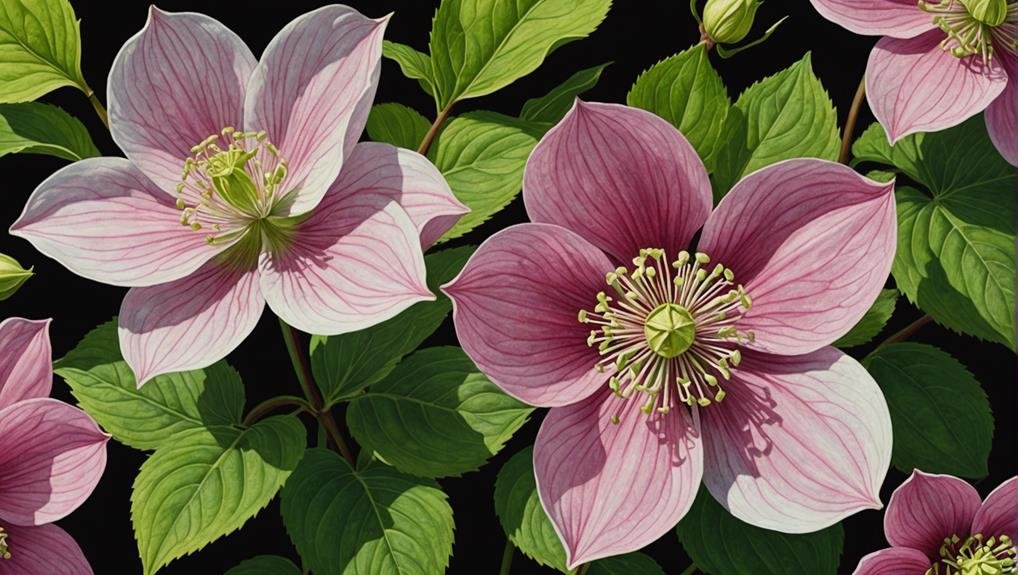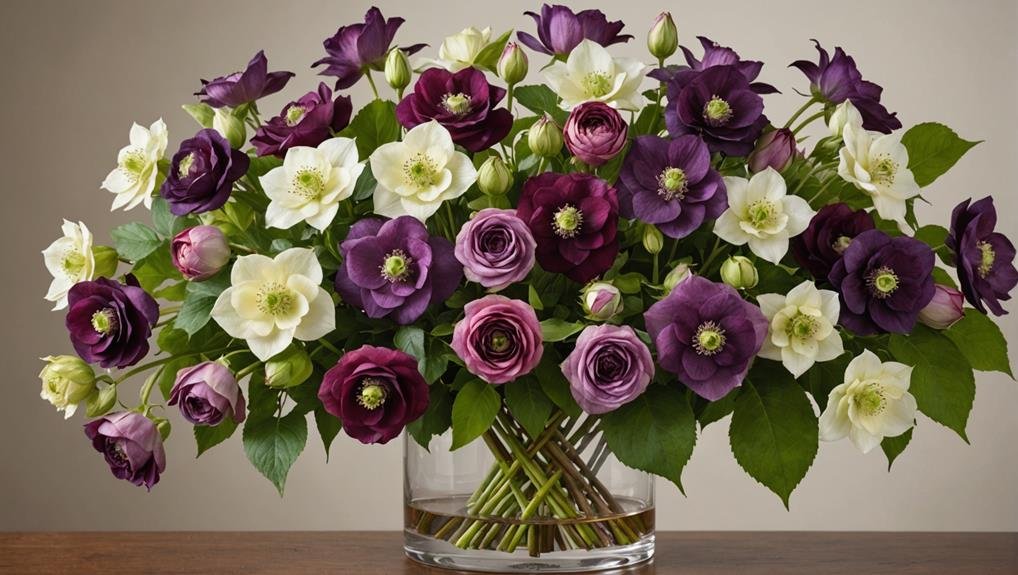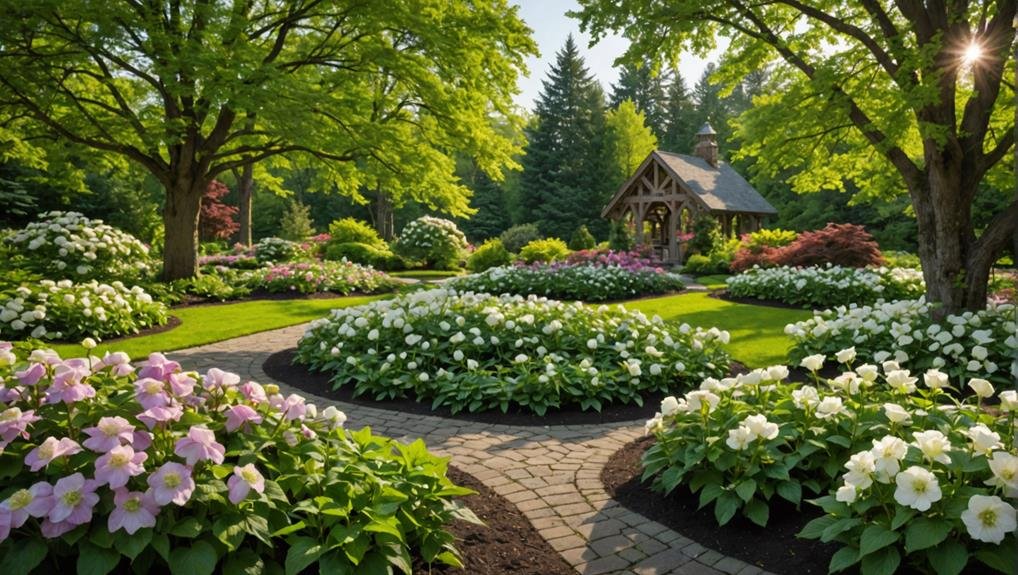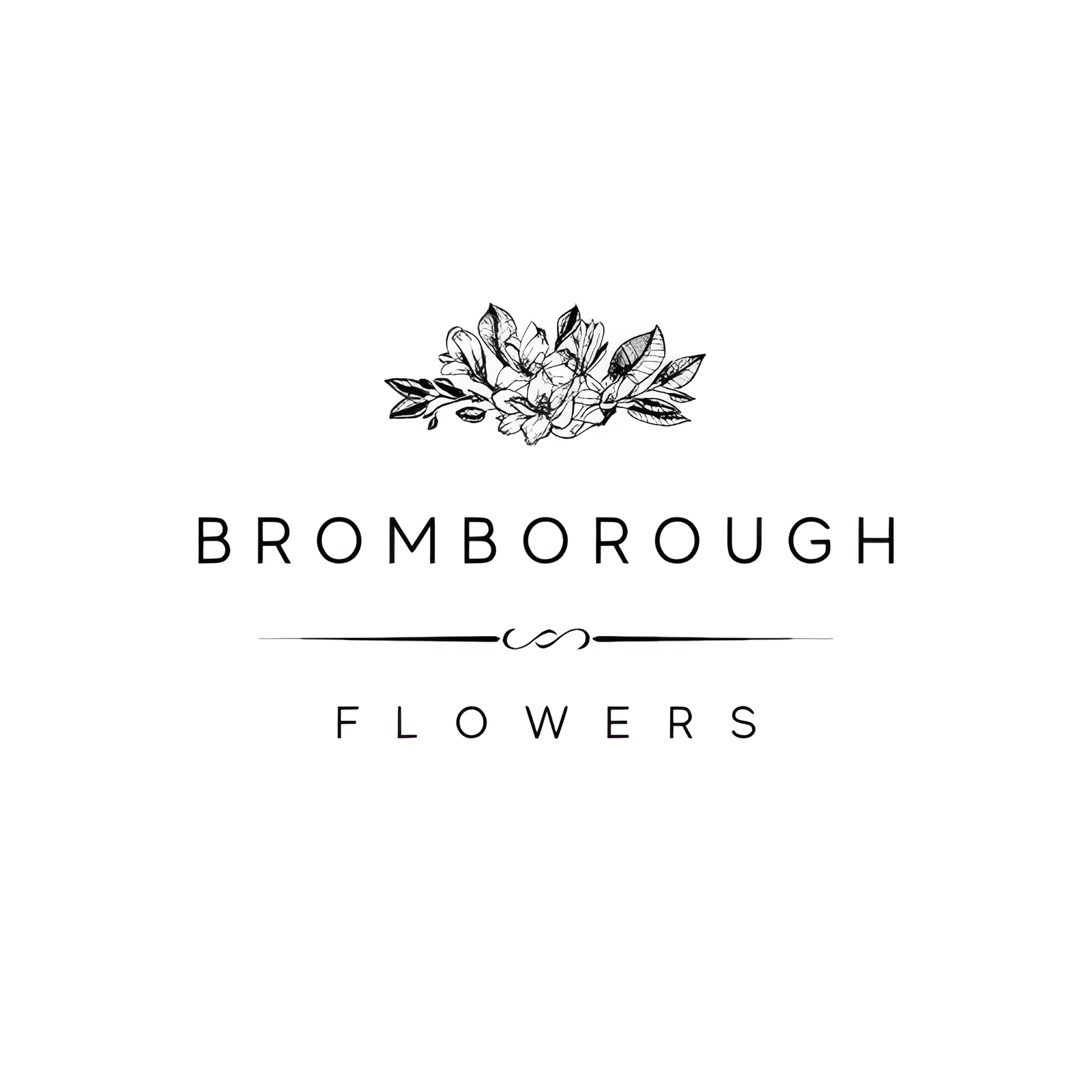The Lenten Rose, or Helleborus x hybridus, presents an intriguing option for wedding florals with its early-season blossoms and array of colors, including black, purple, pink, yellow, white, and light green. Renowned for its resilience in shaded environments, this plant is particularly suitable for ceremonies in less sunlit settings. Beyond its aesthetic appeal, the Lenten Rose holds deep cultural meanings of love, gratitude, and enduring commitment, making it an ideal choice for various wedding arrangements. But what truly sets this flower apart in wedding decor? Understanding its unique attributes and applications could transform your floral decisions.
Flower Overview

The Lenten Rose, scientifically known as Hellebore, is a versatile and aesthetically pleasing flower that comes in a diverse palette of colors, making it a popular choice for weddings. This flower offers a range of hues, including black, purple, pink, yellow, white, and light green, allowing for extensive customization in wedding bouquets.
Especially favored for winter weddings, the Lenten Rose blooms from late winter to early spring, thriving in colder temperatures and adding a touch of natural elegance to floral arrangements. The Wedding Party series by renowned breeder Hans Hansen introduces unique double hellebore varieties such as Wedding Bells, Wedding Crasher, and Wedding Party. These varieties contribute to creating intricate and sophisticated floral designs.
Incorporating Hellebore flowers into wedding bouquets provides a distinctive and elegant floral aesthetic. They can be paired with traditional wedding blooms like roses and lilies or accented with frosted ferns, evergreen sprigs, or pine cones. This combination not only enhances the natural wedding flowers' beauty but also offers couples the opportunity to craft unique floral arrangements that stand out.
As a result, the Lenten Rose remains a preferred choice for those seeking an elegant and timeless look for their wedding day.
Physical Description
Characterized by its dark green, leathery leaves and nodding, cup-shaped flowers, the Lenten Rose presents a striking and resilient addition to any garden or floral arrangement. Also known as Hellebore, this perennial flowering plant belongs to the genus Helleborus and is native to Europe and Asia. The Lenten Rose is particularly valued for its ability to bring early color to gardens, as its flowers bloom from late winter to early spring.
The dark green leaves of the Lenten Rose are not only visually appealing but also highly durable, providing a lush backdrop that enhances the plant's distinctive flowers. These cup-shaped flowers, which nod gracefully from the plant, add an elegant touch to any setting.
Thriving in part to full shade, the Lenten Rose is a hardy plant that prefers well-draining soil, making it an excellent choice for various garden conditions. Its ability to withstand less-than-ideal light conditions while still offering vibrant, early-season blooms makes it a versatile and reliable option for gardeners and floral designers alike.
Whether used in a garden or as part of a wedding bouquet, the Lenten Rose's unique physical characteristics ensure it will stand out beautifully.
Available Colour Varieties

Among the myriad choices for wedding flowers, the Lenten Rose offers an impressive array of color varieties, including black, purple, pink, yellow, white, and light green. This diversity makes it an excellent choice for creating unique and personalized floral arrangements.
The Lenten Rose, or hellebore, is particularly well-suited for winter weddings due to its blooming season starting in late winter and early spring. This allows couples to incorporate fresh, vibrant blooms into their special day, even when other flowers may be out of season.
The double hellebore varieties, such as Maid Of Honor and Blushing Bridesmaid, offer distinct and enchanting color combinations. These unique combinations provide a sophisticated and elegant touch to wedding bouquets and decorations. The versatility of Lenten Roses allows them to be seamlessly integrated with traditional blooms like roses and lilies, creating stunning and personalized wedding bouquets.
Key benefits of using Lenten Rose in floral arrangements include:
- A wide range of color varieties to suit any theme
- Unique double hellebore varieties for added elegance
- Ideal for winter weddings due to their blooming season
- Ability to mix with traditional wedding flowers
- Provides a unique and elegant touch to bouquets
Incorporating Lenten Roses can transform any wedding into a picturesque and unforgettable event.
Latin Name and Taxonomy
Helleborus x hybridus, commonly known as Lenten Rose, is a remarkable hybrid species within the Helleborus genus. This perennial plant is part of the Ranunculaceae family, also known as the buttercup family. The Latin name, Helleborus x hybridus, denotes its status as a hybrid species, resulting from the cross-breeding of various Helleborus species. This careful hybridization has produced a plant known for its diverse colors and forms, making it a popular choice for early spring gardens and wedding floral arrangements.
In terms of taxonomy, the Lenten Rose is classified within the kingdom Plantae, signaling its status as a plant. It belongs to the order Ranunculales and the class Magnoliopsida, which includes many flowering plants. The hybrid species Helleborus x hybridus is distinguished by its early blooming period, often providing the first splash of color in gardens as winter shifts to spring.
Additionally, the Lenten Rose is noted for its shade tolerance, thriving in areas where many other plants would struggle. This characteristic, alongside its perennial nature, ensures that it remains a lasting and vibrant presence in any garden or flower arrangement.
Geographical Origins

Originating from Southern and Central Europe, particularly regions such as Greece and Turkey, the Lenten Rose has a rich geographical history that complements its diverse botanical characteristics. Known scientifically as Helleborus orientalis, these perennial plants are notable for their ability to thrive in temperate climates where mild winters and cool summers prevail.
Belonging to the Ranunculaceae family, the Lenten Rose is highly valued for its early spring blooms and remarkable shade tolerance, making it a versatile choice for gardeners and florists alike.
- Southern Europe and Central Europe: The Lenten Rose can be found across a wide range of locations, from Greece to Turkey.
- Perennial Plant Adaptability: These plants are well-suited to temperate climates, showcasing resilience across different environments.
- Ranunculaceae Family: As members of this diverse plant family, Lenten Roses share characteristics with other popular flowers.
- Early Spring Blooms: Their flowering period aligns with the Lenten season, adding to their seasonal appeal.
- Shade Tolerance: The ability to thrive in shaded areas makes them ideal for various garden settings.
Understanding the geographical origins of the Lenten Rose enriches our appreciation of this elegant plant, highlighting its adaptability and enduring appeal in both natural and cultivated landscapes.
Season Availability
The seasonal presence of Lenten Roses makes them an ideal choice for weddings held in late winter and early spring. Known also as hellebore flowers, these stunning blooms are readily accessible during this shifting period, providing a beautiful and cost-effective alternative to traditional summer flowers. Their presence during the late winter and early spring wedding season guarantees that couples can enjoy fresh, vibrant flowers without the premium costs associated with out-of-season blooms.
Hellebore flowers are not only cost-effective but also incredibly versatile. They come in a variety of colors, including black, purple, pink, yellow, white, and light green, making them suitable for a wide range of wedding themes and palettes. This versatility allows for the creation of unique bouquets and wedding arrangements that can tie the entire wedding scheme together beautifully.
Moreover, hellebore flowers are known for their durability in arrangements. They hold up well when combined with other blooms, enhancing the overall aesthetic of wedding bouquets and centerpieces. The seasonal presence of these stunning blooms offers couples the opportunity to create memorable and elegant floral displays for their special day, making Lenten Roses a preferred choice for many.
Growing Conditions

Lenten Roses thrive best in environments offering part to full shade, making them an excellent choice for gardens with limited sunlight. These perennials are highly adaptable, but they thrive under specific growing conditions that guarantee their peak health and appearance.
For successful cultivation, it is essential to provide them with rich, moist soil that has good drainage. This can be achieved by incorporating compost into the planting site, which enhances both the soil's fertility and its ability to retain moisture.
Proper watering is essential for Lenten Roses. They should be watered when the top layer of soil becomes dry to maintain their vigor. Additionally, applying a balanced fertilizer in the spring can support their growth and promote abundant blooming. Regular maintenance, such as pruning and removing dead growth, is necessary to keep the plants healthy and aesthetically pleasing.
Key growing conditions for Lenten Roses include:
- Part to full shade: Ideal for areas with limited sunlight.
- Rich, moist soil: Enhanced with compost for better fertility.
- Good drainage: Prevents waterlogging and root rot.
- Regular watering: Guarantees soil remains adequately moist.
- Pruning and dead growth removal: Promotes overall plant health and appearance.
Cultural Significance
Beyond their preferred growing conditions, Lenten Roses hold deep cultural significance, particularly in the context of weddings. These flowers are more than just beautiful additions to bridal bouquets and wedding decor; they symbolize love, gratitude, and new beginnings. The long-lasting blooms of the Lenten Rose make them an ideal representation of enduring commitment, a cornerstone of any marriage.
The diverse colors of Lenten Roses—from pristine whites to deep purples—offer a wide range of options for those looking to add a touch of elegance and sophistication to their wedding floral decor. Each color can convey different meanings, allowing couples to personalize their floral arrangements to align with their unique love story.
Moreover, the hardy nature of the Lenten Rose, known for its resilience and strength, makes it a fitting symbol for the trials and triumphs that come with a lifelong partnership.
| Quality | Symbolism | Wedding Context |
|---|---|---|
| Love Symbol | Love and Gratitude | Bridal Bouquets, Centerpieces |
| Enduring Commitment | Long-Lasting Blooms | Ceremony and Reception Decor |
| Diverse Colors | Personalized Meaning | Custom Floral Arrangements |
| Elegance | Sophistication | Upscale Wedding Themes |
| Resilience | Strength | Symbol of Lasting Marriage |
Typical Use in Weddings

When incorporated into wedding designs, hellebore flowers offer a sophisticated and versatile option for bridal bouquets, centerpieces, and other floral arrangements. Known for their unique colors and textures, hellebores provide a distinctive touch that can elevate any wedding theme. These flowers, particularly varieties like those from the Wedding Party series, are available in a range of exquisite hues and patterns, making them perfect for creating memorable wedding arrangements.
Hellebores are especially advantageous for winter weddings, as they bloom from late winter to early spring, providing a fresh and seasonally appropriate alternative to traditional summer flowers.
Here are some typical uses of hellebore flowers in weddings:
- Bridal Bouquets: Their unique textures and colors make hellebores an excellent choice for creating standout bridal bouquets.
- Centerpieces: Hellebores can be combined with other seasonal elements like frosted ferns and pine cones to design stunning centerpieces.
- Boutonnieres: These flowers can be used in boutonnieres, offering a refined and cohesive look for the groom and groomsmen.
- Floral Crowns: Adding hellebores to floral crowns gives a whimsical and elegant touch.
- Table Arrangements: The variety in colors allows for creative and visually appealing table arrangements.
Alternative Flower Types
While hellebores are a charming choice for weddings, other alternative flower types can also add unique beauty and elegance to your floral arrangements. Hellebores are particularly appealing for winter weddings due to their versatility and availability in a variety of colors such as black, purple, pink, yellow, white, and light green. Their double varieties, including Maid Of Honor and Blushing Bridesmaid, offer unique options for wedding bouquets with distinct color combinations.
Incorporating hellebores with traditional blooms like roses and lilies can create stunning and unique wedding bouquets. Additionally, accents such as frosted ferns, evergreen sprigs, or pine cones can enhance the winter wedding aesthetic, making hellebores a cost-effective and elegant floral choice.
Here is a visual representation of alternative flower ideas:
| Flower Type | Unique Features | Ideal For |
|---|---|---|
| Hellebores | Double varieties, various colors | Winter wedding bouquets |
| Roses | Classic beauty, many colors | Traditional arrangements |
| Lilies | Elegant, fragrant | Formal ceremonies |
| Frosted Ferns | Winter accents | Seasonal decorations |
| Pine Cones | Natural, rustic | Winter wedding accents |
